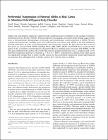| dc.contributor.author | GILL, MICHAEL | en |
| dc.contributor.author | SEGURADO, RICARDO | en |
| dc.contributor.author | GALLAGHER, LOUISE | en |
| dc.contributor.author | HAWI, ZIARIH | en |
| dc.contributor.author | FITZGERALD, MICHAEL | en |
| dc.date.accessioned | 2009-11-26T16:38:30Z | |
| dc.date.available | 2009-11-26T16:38:30Z | |
| dc.date.issued | 2005 | en |
| dc.date.submitted | 2005 | en |
| dc.identifier.citation | Hawi Z, Segurado R, Conroy J, Sheehan K, Lowe N, Kirley A, Shields D, Fitzgerald M, Gallagher L, Gill M., Preferential Transmission of Paternal Alleles at Risk Genes in Attention Deficit/Hyperactivity Disorder, American Journal of Human Genetics, 77, 6, 2005, 958 - 965 | en |
| dc.identifier.other | Y | en |
| dc.identifier.uri | http://hdl.handle.net/2262/34992 | |
| dc.description | PUBLISHED | en |
| dc.description | (239) PMID: 16380908 ABSTRACT: Family, twin, and adoption studies have demonstrated a significant genetic contribution to the etiology of attention-deficit/hyperactivity disorder (ADHD). Pharmacological, neuroimaging, and animal-model findings suggest imbalances in monoaminergic (dopaminergic, serotonergic, and noradrenergic) neurotransmission in ADHD. We have examined monoaminergic candidate genes for possible genetic association with ADHD in the Irish population, focusing particularly on genes of the dopaminergic and serotonergic systems. We have observed that several of these genes are associated with ADHD, including DAT1, DBH, DRD4, DRD5, and 5HT1B. Here, we present what appears to be a systematic overtransmission of paternal alleles at candidate genes associated with ADHD. For the nine genes included in the analysis, the overall odds ratio for paternal transmission was 2, compared with 1.3 for maternal transmission (paternal vs. maternal chi 2=9.6; P=.0019). Transmission to females, from either parent, was significantly stronger than to males. Possible reasons for this preferential transmission include imprinting and ascertainment bias, although results of further analyses show that the latter is unlikely. | en |
| dc.description.abstract | Family, twin, and adoption studies have demonstrated a significant genetic contribution to the etiology of attention-deficit/hyperactivity disorder (ADHD). Pharmacological, neuroimaging, and animal-model findings suggest imbalances in monoaminergic (dopaminergic, serotonergic, and noradrenergic) neurotransmission in ADHD. We have examined monoaminergic candidate genes for possible genetic association with ADHD in the Irish population, focusing particularly on genes of the dopaminergic and serotonergic systems. We have observed that several of these genes are associated with ADHD, including DAT1, DBH, DRD4, DRD5, and 5HT1B. Here, we present what appears to be a systematic overtransmission of paternal alleles at candidate genes associated with ADHD. For the nine genes included in the analysis, the overall odds ratio for paternal transmission was 2, compared with 1.3 for maternal transmission (paternal vs. maternal ?2=9.6; P=.0019). Transmission to females, from either parent, was significantly stronger than to males. Possible reasons for this preferential transmission include imprinting and ascertainment bias, although results of further analyses show that the latter is unlikely. | en |
| dc.description.sponsorship | This work was generously supported by the Health Research Board, Dublin (to K.S., N.L., R.S., J.C., and Z.H.), the Wellcome Trust (to Z.H.), the Dublin Molecular Medicine Centre (to Z.H.), and the Hyperactive and Attention Disorder Group Ireland. | en |
| dc.format.extent | 958 | en |
| dc.format.extent | 965 | en |
| dc.format.mimetype | application/pdf | |
| dc.language.iso | en | en |
| dc.relation.ispartofseries | American Journal of Human Genetics | en |
| dc.relation.ispartofseries | 77 | en |
| dc.relation.ispartofseries | 6 | en |
| dc.rights | Y | en |
| dc.subject | Psychiatry | en |
| dc.title | Preferential Transmission of Paternal Alleles at Risk Genes in Attention Deficit/Hyperactivity Disorder | en |
| dc.type | Journal Article | en |
| dc.type.supercollection | scholarly_publications | en |
| dc.type.supercollection | refereed_publications | en |
| dc.identifier.peoplefinderurl | http://people.tcd.ie/mgill | en |
| dc.identifier.peoplefinderurl | http://people.tcd.ie/zhhawi | en |
| dc.identifier.peoplefinderurl | http://people.tcd.ie/mifitzge | en |
| dc.identifier.peoplefinderurl | http://people.tcd.ie/lgallagh | en |
| dc.identifier.rssinternalid | 33616 | en |
| dc.identifier.doi | http://dx.doi.org/10.1086/498174 | en |
| dc.subject.TCDTheme | Neuroscience | en |
| dc.subject.TCDTag | ADD/ADHD | en |
| dc.subject.TCDTag | ADD/ADHD | en |
| dc.subject.TCDTag | ADHD | en |
| dc.subject.TCDTag | ADHD | en |
| dc.subject.TCDTag | ALLELES | en |
| dc.subject.TCDTag | ATTENTION DEFICIT HYPERACTIVITY DISORDER (ADHD) | en |
| dc.subject.TCDTag | Adolescent Psychiatry | en |
| dc.subject.TCDTag | Attention Deficit Hyperactivity Disorder (ADHD) | en |
| dc.subject.TCDTag | CHILD PSYCHIATRY | en |
| dc.subject.TCDTag | COMMUNITY PSYCHIATRY | en |
| dc.subject.TCDTag | CONSULTATION LIAISON PSYCHIATRY | en |
| dc.subject.TCDTag | CONSULTATION-LIAISON PSYCHIATRY | en |
| dc.subject.TCDTag | DISORDER ADHD | en |
| dc.subject.TCDTag | GENERAL HOSPITAL PSYCHIATRY | en |
| dc.subject.TCDTag | LIAISON PSYCHIATRY | en |
| dc.subject.TCDTag | Neuropsychiatry | en |
| dc.subject.TCDTag | Neuropsychiatry | en |
| dc.subject.TCDTag | PSYCHIATRY | en |
| dc.subject.TCDTag | Psychiatry | en |
| dc.subject.TCDTag | Psychiatry | en |
| dc.subject.TCDTag | child and adolescent Psychiatry | en |
| dc.subject.TCDTag | neurodevelopmental psychiatry | en |
| dc.identifier.rssuri | http://professormichaelfitzgerald.eu/ | en |
| dc.identifier.rssuri | http://www.ncbi.nlm.nih.gov/pubmed/16380908 | en |




